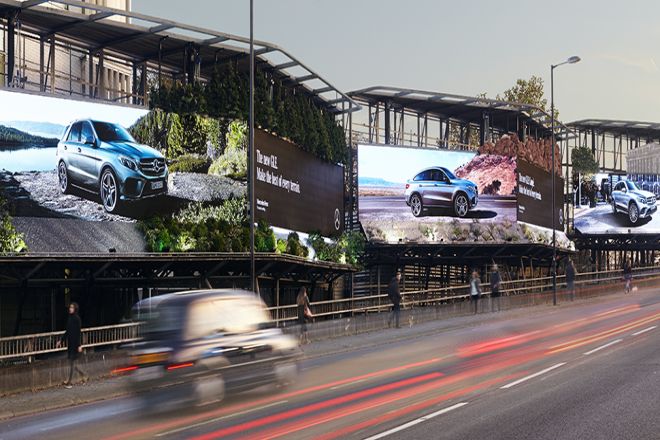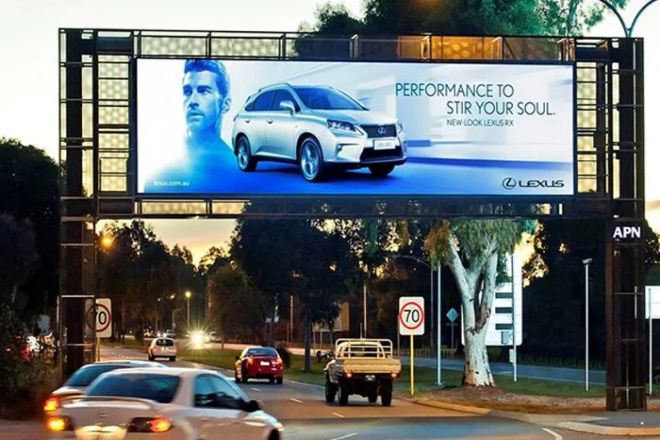Introduction

With the continuous development of science and technology, outdoor LED display screens, as an efficient and intuitive information dissemination medium, have been widely used in urban advertising, public information release, event promotion, and other fields.
Its unique visual effects and powerful information-carrying capacity make outdoor LED displays an indispensable part of modern society. However, due to the complexity and diversity of the outdoor environment, outdoor LED displays face many challenges and tests.
1. Main challenges of outdoor LED displays
While outdoor LED displays provide information display convenience, they also face many challenges. These challenges mainly come from environmental factors, safety factors, and maintenance and upkeep needs.
1). Environmental factors
Outdoor LED displays are directly exposed to the natural environment, so they must be able to cope with various environmental challenges.
- Light intensity:
Direct sunlight is one of the biggest challenges faced by outdoor LED displays. Strong sunlight will cause the brightness of the display to be relatively reduced, thus affecting its visibility. Therefore, the display needs to be bright enough to ensure that the content can still be displayed clearly under direct sunlight.
- Temperature changes:
Outdoor environmental temperatures vary greatly, especially in some extreme areas. This temperature change may adversely affect the performance and lifespan of the display. The circuitry and components of the display need to be able to withstand this temperature change and remain stable under extreme conditions.
- Humidity and waterproofing:
Humid environments may cause corrosion and damage to display circuits and components. Therefore, the display needs to have good waterproof performance to ensure that it can still work properly in humid or rainy conditions.
- Air quality:
Dust, sand, and other particles in the air may adhere to the surface of the display, affecting the display and heat dissipation effects. In addition, pollutants in the air may cause damage to the circuitry and components of the display.
2). Safety factors
The safety issues of outdoor LED displays cannot be ignored.
- Lightning protection and grounding:
Lightning is a common natural phenomenon in outdoor environments and may cause serious damage to the display. Therefore, the display needs to have good lightning protection performance and be protected from lightning damage through reasonable grounding design.
- Windproof and earthquake-proof:
The outdoor environment may face challenges from natural disasters such as strong winds and earthquakes. The display needs to have a solid structural design and be resistant to wind and earthquakes to ensure stable operation under severe weather conditions.
3). Maintenance and maintenance
In order to maintain the best performance and display effect of outdoor LED displays, regular maintenance and upkeep is essential.
- Display screen cleaning:
Clean the display surface regularly to remove attached dust and pollutants and maintain its good display effect. At the same time, cleaning can also help improve heat dissipation and extend the life of the display.
- Part replacement:
With the increase in use time, some parts of the display may become aged or damaged. Timely replacement of these parts can ensure the stable operation of the display and extend its service life. This includes but is not limited to key components such as power modules, driver boards, and LED lamp beads.
2. Selection and design of outdoor LED display

When designing and selecting outdoor LED displays, we need to comprehensively consider multiple key factors to ensure that they can operate stably under various environmental conditions and meet usage requirements. Below is a detailed discussion of brightness and contrast, thermal design, and protection levels.
1). Brightness and Contrast
Brightness and contrast are two key parameters that affect the display effect of outdoor LED displays.
- Brightness:
The brightness of the outdoor LED display needs to be selected according to the actual use environment. In order to ensure that the content is clearly visible under strong light, a high-brightness display screen needs to be selected.
Generally speaking, brightness between 1500~3000cd/m² is more common, but in environments with strong direct sunlight, higher brightness may be required, such as above 2000cd/m². In addition, the brightness requirements of the display screen are different between the sunny side and the shaded side, with the sunny side generally requiring higher brightness.
- Contrast:
Contrast determines the difference in brightness between black and white on a display. High contrast can improve the clarity and layering of the display.
When selecting a model, you should choose a display with high contrast and optimize the contrast through reasonable design, such as using a black mask, optimizing the layout of LED lamp beads, etc.
2). Heat dissipation design
Heat dissipation design is a crucial part of outdoor LED display design. Due to the large temperature difference in the outdoor environment, the display will generate a lot of heat during long-term operation. If the heat dissipation is poor, the temperature of the display will rise, affecting performance and service life.
- The importance of the cooling system:
A good cooling system can ensure that the display maintains a stable temperature during long-term operation, improving performance and reliability. At the same time, a reasonable heat dissipation design can also reduce the energy consumption of the display and extend its service life.
- Common heat dissipation design solutions:
The heat dissipation design of outdoor LED displays can adopt a variety of methods, such as air cooling, liquid cooling, etc. The air-cooling method uses fans and other devices to blow air across the display surface to take away heat. Liquid cooling takes away the heat inside the display through liquid circulation. When choosing a cooling solution, you need to make a choice based on the actual use environment and needs.
3). Protection level
Protection level is one of the important factors to consider when selecting outdoor LED displays. The IP protection rating is a measure of the dust- and waterproof performance of a display.
- The meaning of IP protection level:
The IP protection level consists of two numbers; the first number indicates the dustproof level, and the second number indicates the waterproof level. The larger the value, the better the protective performance. For example, IP65 means that the display is completely protected from dust and can withstand being washed down with water.
- Choose the appropriate protection level:
When selecting, you need to choose the appropriate protection level based on the actual use environment and needs. For dusty or humid environments, you need to choose a display with a higher dustproof and waterproof rating. At the same time, you also need to pay attention to whether the protection level of the display screen complies with local safety standards and regulations.
3. Installation and debugging of outdoor LED display
The installation and debugging of outdoor LED displays is a critical and complex link. It is not only related to the stability and safety of the display, but also directly affects its display effect and service life. The following will be discussed in detail from three aspects: installation location and angle, installation method and fixation, debugging and testing.
- Installation position and angle
When installing outdoor LED displays, it is crucial to choose the appropriate installation location and angle. First, ensure that the display can be clearly seen by the target audience to maximize its visibility and effectiveness. This usually requires considering factors such as foot traffic, viewing distance, surrounding buildings, etc.
At the same time, it is also necessary to consider the impact of the installation location on heat dissipation, waterproofing, and other properties to ensure that the display can operate properly in various environments.
- Installation method and fixation
There are various installation methods for outdoor LED displays; the common ones are wall-mounted, ceiling-mounted, etc. When choosing an installation method, comprehensive considerations need to be made based on the actual environment and usage requirements.
Wall-mounted installation is usually suitable for places with flat walls and strong load-bearing capacity; ceiling-mounted installation is suitable for places with strong ceiling load-bearing capacity and large space. No matter which installation method is used, you need to choose suitable fixings and ensure that they are installed firmly and reliably.
During the installation process, you also need to pay attention to the connection method and tightening degree between the display screen and the bracket to avoid loosening or falling off.
- Debugging and testing
Debugging and testing are key steps to ensure the normal operation of outdoor LED displays. During the debugging process, you need to follow the instruction manual provided by the manufacturer and, step by step, check whether each part of the display is working properly.
First, you need to check whether the green light of the sending card flashes regularly. If it flashes, go to the next step; if it does not flash, you need to restart and check whether the connection line is normal. Next, you need to check whether the green light (data light) of the receiving card flashes synchronously with the green light of the sending card and whether the red light (power) is on.
If everything is OK, enter the testing phase. During the testing phase, professional testing software or equipment needs to be used to test various indicators of the display, such as brightness, contrast, color reproduction, etc. Through testing, the performance and effect of the display can be evaluated to ensure that it meets the usage requirements.
4. Maintenance and maintenance of outdoor LED display

As an important information display tool, outdoor LED display screens have important maintenance and upkeep work. In order to ensure that the display screen can continue to operate stably and extend its service life, the following will introduce in detail three aspects: regular inspection and maintenance, cleaning and maintenance, and fault diagnosis and troubleshooting.
- Regular inspection and maintenance
Regular inspection and maintenance are the basis for ensuring the normal operation of outdoor LED displays. First of all, you need to check whether the appearance and structure of the display are intact, such as whether the screen is cracked or deformed and whether the brackets and fixings are firm.
Secondly, you need to check whether the cooling system, circuit system, etc. are working properly. The heat dissipation system is the key to ensuring the stable operation of the display. The dust on the radiator and fan needs to be cleaned regularly to ensure good heat dissipation. For the circuit system, it is necessary to check whether the lines are aging, loose, or damaged and whether the power supply is functioning normally.
In addition, the data and settings of the display screen need to be backed up regularly to prevent data loss due to unexpected circumstances.
- Cleaning and maintenance
Cleaning and maintenance are important measures to maintain outdoor LED displays. Due to the complex and changeable outdoor environment, dust and dirt are prone to accumulate on the surface of the display screen, affecting the display effect.
Therefore, the display needs to be cleaned regularly using suitable cleaning methods and tools. During the cleaning process, avoid using an overly wet cloth or detergent to prevent liquid from penetrating into the display and causing damage. At the same time, you also need to pay attention to maintenance measures such as waterproofing and dustproofing to ensure that the display screen is dry and clean.
For example, in rainy seasons or humid environments, waterproofing measures need to be strengthened, such as installing rainproof covers or waterproof sealing strips.
- Troubleshooting and troubleshooting
During the use of outdoor LED displays, some failures will inevitably occur. For common faults, such as black screen, blurry screen, uneven brightness, etc., timely fault diagnosis and troubleshooting are required.
First, you need to understand the causes and manifestations of common failures in order to quickly locate the problem. Secondly, you need to master some basic fault diagnosis and troubleshooting methods, such as checking whether the power supply is normal, whether the circuit is loose or damaged, whether the driver board is faulty, etc. During the troubleshooting process, you need to pay attention to safe operations to avoid secondary damage to the display.
If you cannot solve the fault by yourself, you can contact professional maintenance personnel for repair and maintenance.
Conclusion
Through an in-depth discussion of the key factors and response strategies of outdoor LED displays, it is not difficult to find that ensuring the efficient and stable operation of outdoor LED displays is not easy.
From selection and design to installation, commissioning, and maintenance, every step requires careful consideration and rigorous operation.
Finally, if you want to know more about LED displays, please get in touch with us.
